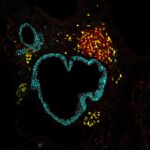
Publication: Natural killer cells are required for extramedullary hematopoiesis following murine cytomegalovirus infection.
Published in: Cell Host and Microbe, 2013, 13 (5), pp.535-45. ⟨10.1016/j.chom.2013.04.007⟩
Authors: Stefan Jordan, Zsolt Ruzsics, Maja Mitrović, Thomas Baranek, Jurica Arapović, Astrid Krmpotić, Eric Vivier, Marc Dalod, Stipan Jonjić, Lars Dölken, Ulrich H Koszinowski
Summary
The immune response against a variety of pathogens can lead to activation of blood formation at ectopic sites, a process termed extramedullary hematopoiesis (EMH). The underlying mechanisms of EMH have been enigmatic. Investigating splenic EMH in mice infected with murine cytomegalovirus (MCMV), we find that, while cells of the adaptive immune system were dispensable for EMH, natural killer (NK) cells were essential. EMH required recognition of infected cells via activating NK cell receptors Ly49H or NKG2D, and correspondingly, viral interference with NK cell recognition abolished EMH. Surprisingly, development of EMH was not induced by NK cell-derived cytokines but was dependent on perforin-mediated cytotoxicity in order to control virus spread. Spreading virus reduced the numbers of F4/80(+) macrophages that were crucial for inflammatory EMH. Hence, whereas MCMV suppresses inflammation-induced EMH, NK cells confine virus spread, thereby protecting extramedullary hematopoietic niches and facilitating EMH.
Link to Pubmed [PMID] – 23684305
Link to HAL – univ-tours-01118335
Link to DOI – 10.1016/j.chom.2013.04.007


